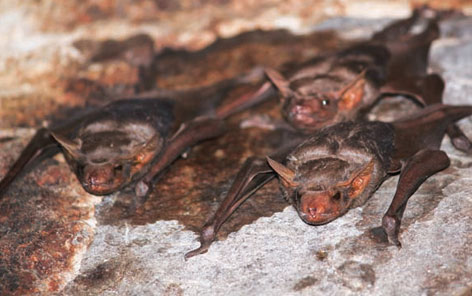Dark Knights of the RuinsBy: JESSICA LUIS & ARISTO MENDIS
Vigilantes, not vermin...
Jessica Luis and Aristo Mendis
stumble upon the real life bat
caves of an urban landscape...
 |
| Lesser Mouse-Tailed Bat(Rhinopoma hardwickii) |
It was a typical sweltering Delhi
noon and the class was walking
through the lanes of Mehrauli
on a field trip. We were being run
through how the town looked once
upon a time, where lakes and
orchards once stood, and weaving
in and out of forts and ruins left
behind from a bygone era. By the
time we came to Jahaz Mahal,
everyone was looking up at the
domes and admiring the
architecture of the now abandoned
building, and furiously scribbling
notes and diagrams of corbelled
arches and true arches.
Suddenly, out of the blue we
saw a tiny bat hanging stealthily
on the darker side of a wall. The
Lesser Mouse Tailed Bat, had been
there, unnoticed, while we were
looking up at the ornate
decorations of the impressive
structure.
This got us wondering. How
many of these elusive winged
mammals do we unknowingly
share our space with in this city?
Where do we find them? What
do they actually do? Do they just
hang around monuments, hidden
from sight during the day and then
fly around to hunt at night?
But most importantly, does
anyone give a damn about them?
So many questions and so few
answers...
So we decided we'd do a little
research of our own, in and
around Delhi. Turned out Jahaz
Mahal was not the only monument
these creatures inhabited.

Bats are nocturna, l so we
humans tend to interact minimally
with them since we share different
spaces and time frames, which is
why we cloak them with a shroud
of myth and mystery. They also live
in abandoned areas, places that we
humans tend to fear and neglect.
There are many places in this city
where these winged mammals
congregate, which may be known
or unknown to us. Apparently on
hot summer days, bats prefer to
roost in the cool darkness of forts
and ruins to escape the heat,
before they go out to hunt at night.
The first was Khirki mosque in
the heart of bustling Saket, New
Delhi. It took us a while to find the
now abandoned building amidst
the winding lanes. When we finally
got there, we asked some kids
where the "Chamkadar" were. The
pungent smell of guano and the
rustling of wings was a giveaway.
As we entered the cave, we had to
duck as a hundred Lesser Mouse
Tailed Bats whooshed over our
heads.
For the next few hours we
covered other historical monuments in Delhi that these
bats may call home, like Agrasen
ki Baoli and Humayun's tomb.
Armed with torches, we looked in
damp dark places listening to
high-pitched squeaking and the
rustling of wings, surrounded, by
the scent of guano. The number of
bats we found that day was
astounding. From hordes of lesser
Mouse Tailed bats, to tiny shy
Pipestrelles. They were hard to
identify, which made us realize
how little we know about these
impressive creatures.
Bats happen to be the most
species rich order of mammals in
India. For instance, the felid order
that includes the tiger and leopard
has only fifteen species. In
comparison, the order of bats or
'Chiroptera' in India sum up to
more than 114 representative
species. But surprisingly, there
have been almost no studies done
on them in our country.
A daunting fact that we came
across is that, all bats in India
except for Wroughton's Free-tailed
Bat and Salim Ali's Fruit Bat are
considered 'vermin' under
Schedule V of the Wildlife
(Protection) Act, 1972. This has
been criticised by a lot of
naturalists.
We interviewed one of the very
few people working on the bat
fauna of Delhi, Sumit Dookia who
teaches at the M.Sc. Biodiversity &
Conservation course at GGS
Indraprastha University, New
Delhi. He is at present working on
the status and taxonomy of bats in
Delhi region.
If the vermin status is considered to be a hardbound fact,
then what about the ecological importance that bats serve? |
 |
Bats in general are divided into two
basic and generic groups - the first
being comparatively large fruit-eating
bats (Megachiroptera) and the second
ones include all small insectivorous bats
(Microchiroptera) with unique nose
features. The large ones inhabit trees
and open canopies. And these are the
ones that usually aid in seed dispersal.
The remaining bats are the ones that
inhabit caves and old monumental
structures. These ones are
predominantly the ones who aid in
pest control. |
He thinks public opinion is very
much against bats. And many a
times, this is due to mythological
grounds. "Some feel that bats can
attack people and suck blood, but
this too is not the apparent case.
One of our motives is clear out
these myths among the general
populace", he says.
When we asked him about his
opinion regarding the bats that
share the urban landscape with
humans in Delhi, he quotes, "So
far bat fauna of Delhi has not yet
been explored as such. I feel that
the security of all major
monuments is with ASI
(Archaeological Survey of India)
and bats belong under the purview
of the forest department. One of
the reasons no extensive studies
have been done as of yet maybe
due to the over-interference of ASI
(Archeological Survey of India) and
Forest Department in this matter.
The coordination between these
two organizations also seems to be
completely lacking."
While we may be far away from
adapting trends in other places
where people are exploring the
likes of cave tourism and tolerance
towards bats, we can probably try
to co-exist with these creatures
that share our urban space.
So next time you look up at the
night sky, do try to notice these
nocturnal vigilantes who live
amongst you.
